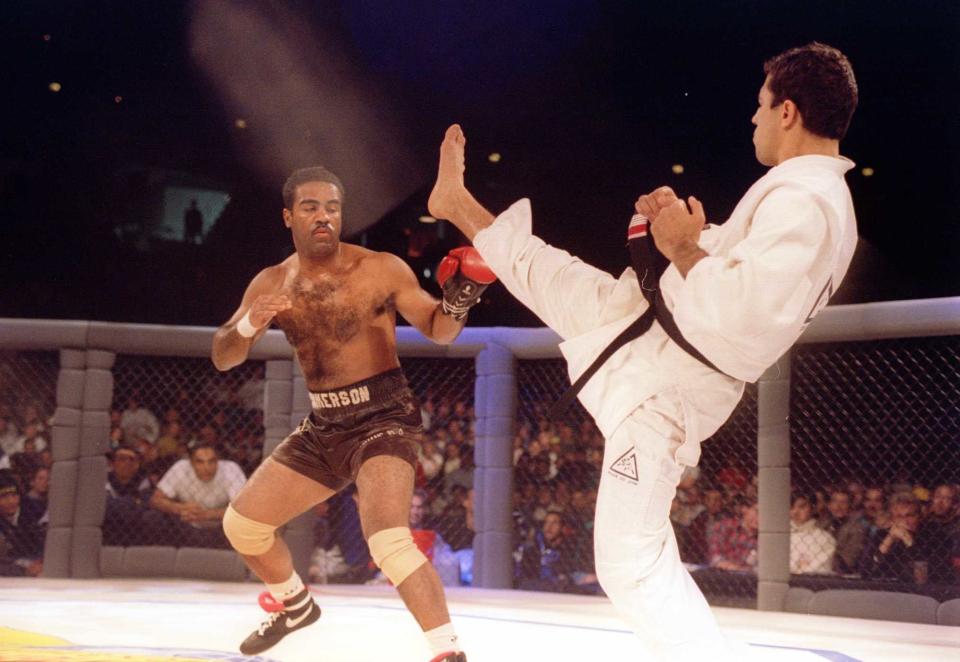UFC founding father finally receives Hall of Fame honor

These days, the idea of mixing the martial arts is so deeply embedded into our sporting culture that the entire notion is taken for granted.
In the late 1980s and early 1990s, however, the combat sports world was a very different place.
Boxing had long been considered by polite society to be the one true way to determine the world’s best fighter. But the martial arts revolution inspired by Bruce Lee had filtered into the public’s consciousness and was knocking on the sporting establishment’s door.
Every strip mall in the country, it seemed, had its own karate dojo. And as more styles came to the fore, so, too, did the questions: How would a karate practitioner fare against the world boxing champ? What would happen if you matched up a wrestler with a taekwondo black belt? How would a judo or jiu-jitsu player fare against any of the above?
In 2018, the Ultimate Fighting Championship is a multi-billion-dollar corporate entity. But long before it became a juggernaut, someone had to get the ball rolling on the attempt to answer which fighting style was best.
That man was Art Davie. The Brooklyn-born Davie, an entrepreneurial sort who worked in advertising and as a car salesman, had exactly the skills required to bust down doors and will into existence the groundbreaking UFC 1, held on Nov. 12, 1993, in Denver.
And with the UFC celebrating its 25th anniversary throughout 2018, the time is right for Davie to be honored for his contribution to the sport. Davie will be inducted into the UFC Hall of Fame, as part of a class headlined by Ronda Rousey on July 5 at the Palms in Las Vegas.
“Art’s contributions to UFC helped lay the foundation for the sport that fans around the world see today,” UFC president Dana White said. “It’s an honor to induct Art into the UFC Hall of Fame class of 2018 and we look forward to celebrating his career at our ceremony.”
Davie was based in Southern California and trained with the legendary Rorion Gracie in Torrance, California, in the late 1980s. The Gracies made waves in the martial arts world at the time by issuing the “Gracie Challenge,” in which all comers were welcomed to the gym to try to defeat the family’s trademark jiu-jitsu. Davie used his ad-man skills to build a successful mail-order business selling VHS tapes of fights filmed in the Gracie’s garage, which made him dream bigger.
“I just knew this was a million-dollar idea.” Davie told Yahoo Sports. “Everyone wanted to know, going back to when I was a kid, what if Bruno Sammartino fought Muhammad Ali? Who has the best fighting style? I didn’t know how I was going to make it happen, but I knew I had to.”
Making such an event happen was a challenge on multiple fronts. Gracie was primarily interested in running his gym. He was intrigued by the idea of putting his family’s jiu-jitsu on a bigger platform, but let Davie handle the business aspect.
Television executives from HBO to Showtime to ESPN turned down his pitches, thinking the spectacle would be too gruesome for the public to accept. But Davie wouldn’t take no for an answer, and eventually, pay-per-view distributor Semaphore Entertainment Group, whose biggest previous event had been a one-off New Kids on the Block concert telecast, signed on to make the event.
Then came the matter of finding fighters willing to participate in the event. Popular martial arts magazines of the time were filled with blustery characters who claimed their system was the one and only true martial art, with the most ridiculous of them claiming to have magical death touches and paralyzing blows.
When it was time to try to get any of them to put their skills on the line, though, all of a sudden the magazine cover boys were tough to find.
“There was so much BS,” Davie said. “No one wanted to be the one who put his reputation on the line, and people thought we were going to rig things in favor of the Gracies. There was always an excuse why someone couldn’t do it.”
Somehow it all came together, in a story captivatingly told in Davie’s 2013 autobiography “Is This Legal? The Inside Story of the First UFC From the Man Who Created It,” co-authored with popular longtime MMA color commentator Sean Wheelock.
As detailed in the book, which has been optioned for a potential motion picture, a ragtag group of fighters put on a show unlike any ever before seen. In the first fight in UFC history, Dutch kickboxer Gerard Gordeau sent Hawaiian sumo Telia Tuli’s teeth flying with a kick, and Gordeau ultimately landed in the hospital with an infection from the teeth fragments which ended up embedded in his foot. Boxer Art Jimmerson curiously decided to fight Royce Gracie wearing one boxing glove, creating MMA’s first iconic image.

Gracie ultimately went through Jimmerson, fellow legend Ken Shamrock and Gordeau to win the one-night tournament at McNichols Arena – the site selected in large part because Colorado was one of the few states which had not expressly banned bare-knuckle fights – and the $50,000 grand prize.
Then the PPV numbers came in: 86,592 buys, far bigger than the initial projection of about 30,000. Easily offended old-school sportswriters were triggered by the event and began their performative pearl-clutching routine, turning the UFC into a controversial entity and significantly boosting sales of further events.
By UFC 5 in 1995, headlined by a Royce Gracie-Ken Shamrock superfight, the company was up to 260,000 PPV buys. Davie decided to get out not long thereafter, selling his share to SEG. Within two years, the UFC was booted off most pay-per-view television outlets and remained a pariah for several years before the company made its well-documented turnaround starting around 2005.
“You could see what was coming,” Davie said. “You could see the trouble on the horizon. It was simply time to get out.”
Davie, who now lives in Pahrump, Nevada, was largely absent from the fight business until his book was released. But while he got on with his life after selling the company, he also admits that he views the current UFC’s success with the eyes of a proud papa.
“It’s an honor to have the UFC recognize me,” Davie said. “It kind of feels like you’re watching your kids grow up and making a success of themselves. And I think it can still get bigger. You think about markets like China and India that have barely been tapped, I think this can blow up even bigger than we’ve imagined.”
More from Yahoo Sports:
• Why Conor McGregor’s bank account is suddenly the topic du jour
• What Kevin Durant’s reported opt-out really means for Warriors
• TV host makes racist gesture when South Korea saves Mexico
• Paul George to opt out of his contract and become a free agent


